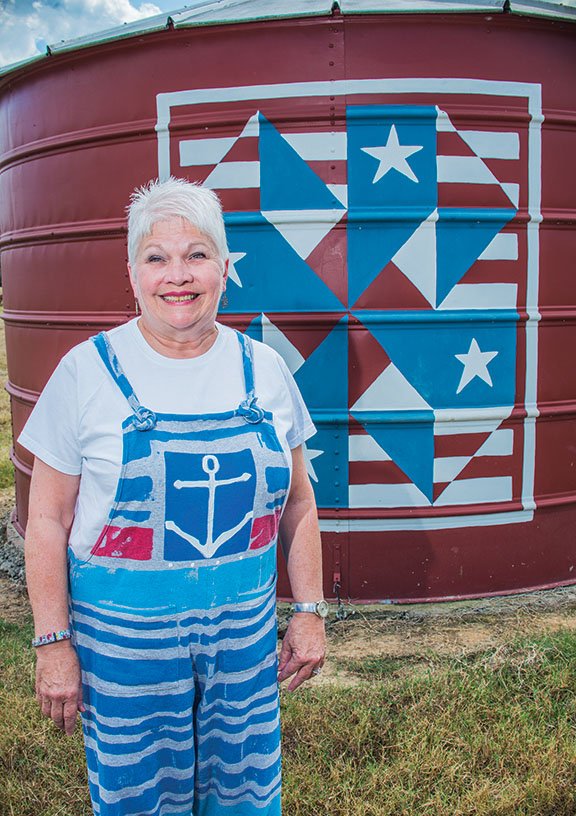Debbie Park of Perryville doesn’t use a needle and thread to make colorful quilts; she uses a paint brush and wood.
Park creates barn quilts, which are quilt squares painted on boards and displayed on the sides of barns, or painted directly on the buildings. Park and her husband, Tommy, run Double D Lazy T Ranch and bed and breakfast on their 320-acre farm in Perryville, the community where they both grew up.
“I take all these country magazines,” Park said, including one simply named Country. “One [photo] spread they had was highlighting a barn-quilt tour in Ohio. I just thought that was the neatest thing.”
In 2001, Donna Groves of Ohio started a movement when she painted a quilt square on a barn to honor her mother, who was a well-known quilter, Park said. Others in the Adams County community painted quilt designs for their barns, which created a trail that
people could follow, and the Ohio Quilt Barn Trail was born. The idea spread to other states, wrote Groves and her co-author, Suzi Parron, in the book Barn Quilts and the American Quilt Trail Movement.
Park decided she wanted to try her hand at painting barn quilts, too.
“We’ve got all these barns, but I didn’t have the first clue how to do it,” she said. Although she’s a former home economist, Park said, she doesn’t paint on canvas, and she doesn’t quilt.
First, she called the chamber of commerce in the Ohio community featured in the magazine and asked if anyone could give her pointers. That was a bust; she said no one called her back.
“Tommy and I put our heads together and figured it out,” she said. “The first was a big one, and he like to have never got it hung.”
It was 8 feet by 8 feet, but some of the quilts are painted on 4-by-4-foot pieces of wood.
To make the barn quilts, Park said, she either gets a pattern from her sister, Pat Hatfield, who lives next door, or she searches the Internet for patterns.
“My sister quilts, and she does a beautiful job,” Park said. “I say she’s the real quilter, and I’m the play quilter.”
Park traces the pattern with a pencil on notebook paper first; then she paints the background of the plywood, usually white, to seal it. Using pencil and ruler, she draws her pattern on the wood. “The dimensions of each particular piece, I kind of guestimate,” she said. She paints her quilt pattern with whatever colors of paint she happens to have, usually red, white, blue and gold to match her red barns.
One quilt she painted directly onto an old grain silo on the property, after she unsuccessfully tried to give the silo away.
“We said, ‘We’ll leave it where it sits and make a silk purse out of a sow’s ear.’ It’s one of my favorites; it’s red, white and blue,” she said
One barn has three different quilt designs displayed on it. She completed her seventh barn quilt in September, and it took her three days.
“They make me smile every time I pull into the driveway,” she said.
The land belonged to her father, Deb (short for Delbert) Williams, who divided his 1,200-acre farm among his three children before he died in 2010, Park said. She was a home economist for the former Arkla Gas, then the Heber Springs School District. She left the school and worked in sales for Heber Springs artist Glynda Turley, and then Park owned a gift shop. Tommy Park is retired from the U.S. Army Corps of Engineers.
The Parks were living in Heber Springs, and they decided to move to the farm in 2007 and build a barn with living quarters in it. After he later built a home on the property, Park said, her
husband got the idea to use the barn as lodging for a bed and breakfast. They opened it about 2 1/2 years ago, she said.
Guests to their farm, who hail from all over Arkansas and as far away as Alaska, admire the barn quilts as a novel idea, she said. Park said she and her husband travel quite a bit and haven’t seen any other barn quilts in Arkansas. On a barn-quilt-trails website, Randolph County is the only one designated in Arkansas.
“We just went to Vermont on vacation week before last, and they had some gorgeous ones up there,” Park said.
Painting barn quilts is a passion limited only by space.
“Tommy says I have run out of barn walls, but sitting right here, I see one whole barn wall that has nothing on it,” she said, laughing. “There’s always room for more.”
Senior writer Tammy Keith can be reached at (501) 327-0370 or tkeith@arkansasonline.com.
